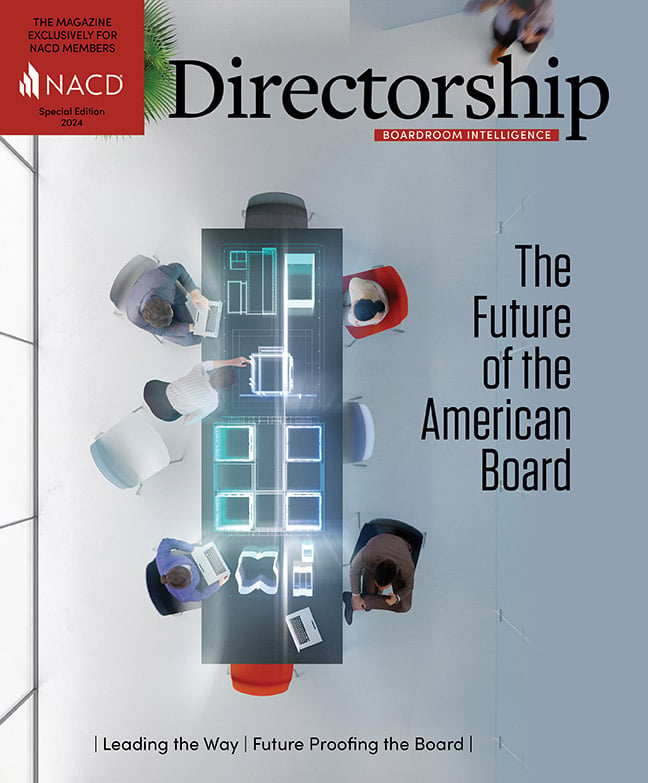
Governance Surveys
Article From Our Partner
Turn the Nominating and Governance Committee Into a Strategic Asset
Over the past three years, whirlwind changes—including the global pandemic, social justice movements, geopolitical conflicts, economic uncertainty, and climate-driven disasters—have transformed board workloads and agendas. No board has been left untouched.
At the still, calm center of the storm, the nominating and governance committee has been focused on improving board performance, composition, and culture, knowing that its work would lead to the board operating either as a corporate asset or a liability, depending on how effectively the board fulfills its responsibilities and supports the company’s long-term success.
Investors and other stakeholders are interested in understanding how boards operate and whether they are fulfilling their oversight responsibilities effectively. This investor and broader stakeholder scrutiny of board performance is a permanent feature of corporate governance, though the issues raised with boards will evolve over time.
As a result, the nominating and governance committee must continue to focus on evaluating directors’ skills and expertise, identifying gaps in the board’s capabilities, and recruiting new directors who can fill these gaps. The committee is also being challenged to increase its rigor and to broaden the scope of its work.
Based on the recently published Future of the American Board Nominating & Governance Committee Blueprint, below are five key areas of focus for the nominating and governance committee to turn the committee and the board itself into strategic assets for the company.
1. Setting board culture and expectations for directors. The nominating and governance committee plays a critical role in establishing and maintaining a diverse and inclusive board. The committee should help define and ensure an inclusive board culture, set (written) expectations for directors, design rigorous renomination processes, and ensure that board leadership (the board chair or lead independent director and committee chairs) reinforces the agreed-upon culture, expectations, and processes.
2. Aligning board composition with corporate strategy. The nominating and governance committee oversees the selection of the board members. A key responsibility of the committee is ensuring that board composition is aligned with the long-term corporate strategy. To do this, the committee must create a long-term succession plan, enable regular refreshment of the board, and plan for board leadership succession.
3. Fostering continuous improvement in board performance. The nominating and governance committee plays a crucial role in fostering continuous improvement in board performance. By ensuring that all board members have a thorough onboarding, enabling high-quality continuing education opportunities, and requiring rigorous board and committee self-evaluation, the committee can prepare the board to meet the challenges facing the company and deliver on its strategic objectives.
4. Improving oversight of cross-board matters that often fall to nominating and governance committees. The nominating and governance committee plays a vital role in overseeing issues that span multiple committees. Specifically, the committee may be responsible for CEO and executive succession, oversight of sustainability matters including climate risk, and decisions about whether to form new committees.
5. Overseeing board involvement with shareholders and other key stakeholders. The nominating and governance committee plays a crucial role in overseeing the involvement of the board—at the request of management—with shareholders and other key stakeholders, including employees, customers, suppliers, regulators, and the broader community. The ever-changing environment that companies operate within has required boards to be more attentive and aligned with the increasing expectations among stakeholder groups in recent years. Effective engagement with these stakeholders is essential for the organization’s success, and the committee can help ensure that the board is prepared to carry out this role.
The next step is for the nominating and governance committees to discuss the blueprint and decide which of its recommendations make sense for their own boards. Given the continuous disruptions to the business environment, this exercise is only likely to be the start of a continuous process of updating and modifying the nominating and governance committee’s charter and processes to ensure the committee and the board remain strategic assets. ■
Korn Ferry is a NACD partner, providing directors with critical and timely information, and perspectives. Korn Ferry is a financial supporter of the NACD.
This article is from the Directorship Special Issue 2024: The Future of the American Board.

Anthony Goodman is a senior client partner and head of the Board Effectiveness Practice at Korn Ferry.

Julie Norris is a senior client partner in Board and CEO Services at Korn Ferry.
